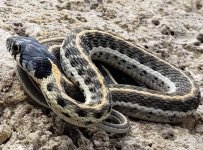| Range: |
 |
| Other Names: |
Garden Snake, Gardener Snake, Grass Snake |
| Description: |
The top of the head is uniform gray with a light yellow to orange
middorsal stripe separates 2 large blotches at the back of the neck.
Olive gray to olive brown above, with 2 alternating rows of black or
brown spots. Belly light greenish white or bluish white. Scales are
keeled. Adults are 16"-46" in length. |
| Similar Species: |
The Checkered Garter usually has 21 scale rows at midbody and side stripe on front of body is confined to 3rd scale row. Checkered pattern extends well out onto tail. The Mexican Garter has 19 or 21 scale rows at midbody and side stripe anteriorly is on 3rd and 4th scale rows. The Common Garter lacks or has less well defined dark neck blotches and usually has red or orange barkings on sides. The Wandering Garter has a paler (and never yellow-orange) vertebral stripe and a venter with dark markings; the neck blotches,if present, are indistinct. Patchnoses and whipsnakes have smooth scales, no spots and a divided anal plate. |
| Venom: |
Garters were long thought to be nonvenomous, but recent discoveries have revealed that they do in fact produce a mild neurotoxic venom. Garter snakes cannot kill humans with the small amounts of venom they produce, which is comparatively mild, and they also lack an effective means of delivering it. They do have enlarged teeth in the back of their mouth, but their gums are significantly larger. The Duvernoy's gland of garters are posterior (to the rear) of the snake's eyes. The mild venom is spread into wounds through a chewing action. - Wikipedia |
| Habitat: |
A stream snake of foothills, high plateaus and mountains. Habitats
vary-desert, grassland, mesquite flats, chaparral covered hillsides,
oak woodland and forests of pine and fir. Frequents permanent,
intermittent streams and springs. |
| Behavior: |
During wet season may wander far from water. |
| Hibernation: |
|
| Reproduction: |
Breeds in early spring
and is live bearing to 7-25 young. |
| Diet: |
Feeds on frogs, toads, tadpoles, fish, salamanders, lizards,
earthworms and small crustaceans. |
Authored by: Garth Teitjen
Sources:



|













